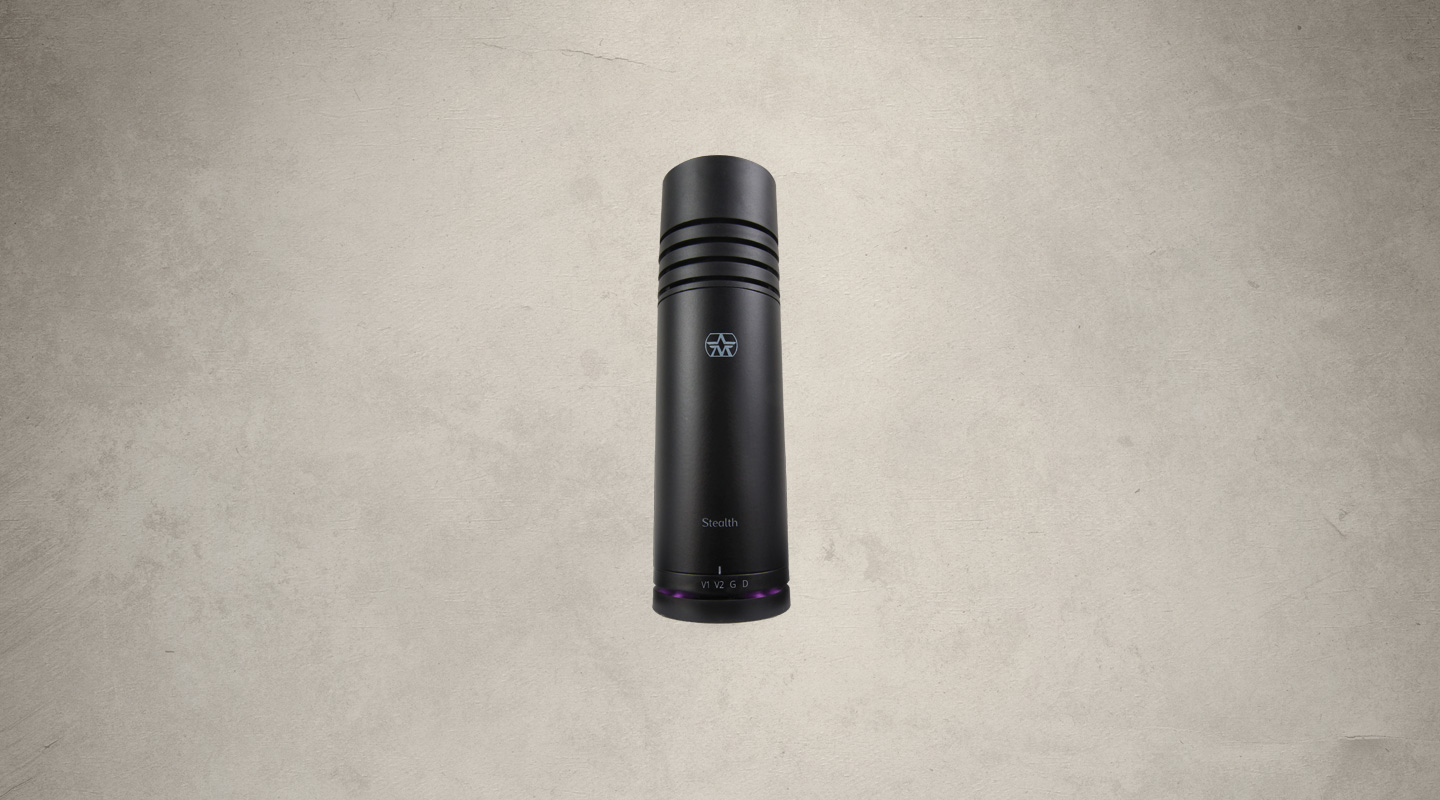
Review: Aston Stealth
Aston reinvents the large diaphragm mic from the clip to the head basket and all the voices in between.
You know you’re pushing the envelope of mic design when you have to include a separate one-page manual explaining how to adjust a switch.
For a long time, mic switches have had opposing outcomes. On the one hand, you want the switch to make it obvious what you’re, you know, switching. But you also don’t want to place it in a spot where it can accidentally switch between polar patterns, or bump in a pad, while it’s in use. Accommodating for this pragmatic tension, switches are typically either incredibly tiny and stiff (if mounted on the mic face), or hidden out of sight and out of reach.
The switch on Aston’s Stealth has four positions. So how do you place it topside and not subject it to constant flicking between states? Enter the rotatable collar, which requires you to wrap your entire thumb and forefinger around it in order to engage rotation. If you simply grasp it with your fingertips, as would seem natural to do, it won’t budge one bit. Hence the manual.
As much as I love my Shure SM7, I do hate having to peer into the slots of its backside to know whether I’ve switched in the high-pass filter or left it flat. Then having to find a key or screwdriver to toggle them back and forth… eurgh, finicky. (Almost as bad as having to unscrew a thread adaptor that hasn’t been moved in decades.)
Stealth’s unique rotatable collar does both jobs: it keeps your filter selection visible without leaving it susceptible to accidental bumps.
The switch contains four voicing selections. V1 is the flattest of the lot and aimed at male vocals. The high-pass filter gets progressively more pronounced on the V2 (female vocals suggested) and G (for guitars) settings. Then the bass gets a big broad bump for the D (for dark) setting, designed to mimic more of a rounder, ribbon-like capture. There’s no switchable pad or separate high-pass filter. The pushbutton on the rear is only to turn the purple ring light on and off that appears when you give it phantom power.
ASTONNOVATION
Aston has also shaken up the rest of the mic’s design. When you think of a normal mic clip — whether it’s a standard issue accessory, shock mount or ring mount — it usually involves inserting the mic into the clip. Aston has flipped it the other way around so you insert Stealth’s stand mount into a slot in the rear of the mic.
It doesn’t require a push button, or a locking mechanism. Once it’s clicked into place, you can comfortably hang Stealth upside down by the clip. If you want to take it off, you simply yank the mic off.
Most large, cylindrical broadcast mics like Stealth are tethered to a yoke stand mount. The yoke is fixed to the chassis, which means you have to unscrew the entire mount to take the mic off its stand. Or in the case of the Procaster, its ring mount requires you to screw it onto the stand, then onto the mic.
Aston’s method makes mounting or de-mounting Stealth from a stand as quick as it can get. The one downside of having it clip into the rear is all the weight of the mic is levering against the clips swivel joint. While it stays in place, it only takes a bit of downward force on the mic to move. It doesn’t seem to sag after it has moved, like other swivel joints can, but at least the central yoke design of the SM7 means it will always stay balanced.
The new insertable clip means there’s no external shock mount, which is why Aston has incorporated an internal Sorbothane one so you don’t have to deal with excessive handling noise.
As it has done before with the Origin’s squishable head basket and Starlight’s sintered capsule, Stealth’s front end is also unique. It’s made of a flexible, but tough plastic that won’t shatter when you drop it. It’s likely also a simpler material for Aston to mould, making the gills required for its polar pattern directivity easier to construct and highly reproduceable.
Need to Know
Aston Stealth
Large Diaphragm Dynamic Microphone
GAIN INSIDE
I put up the Stealth against three other large diaphragm dynamics; a Shure SM7B, a Rode Procaster, and one of the new Rode Podmics.
Presented with the same level source, the Rode Procaster is the most sensitive, followed by the Rode Podmic, then the Aston Stealth, and coming in at the rear is the Shure SM7B. Anyone who has used an SM7B will know it takes a preamp with 60dB of clean gain — or a Cloudlifter ‘mic activator’ — to get the most out of it.
The Rode mics are built to interface with affordable equipment like the Rodecaster podcasting interface, and have sensitivities to match.
The Aston Stealth has its own trick to play. Feed it phantom power and it triggers the internal preamp. It doesn’t act like a booster — in the way a Cloudlifter simply adds a handful of gain to your SM7 — in most cases it provides all the gain you’ll need. So make sure to turn your mic preamp right down before turning on phantom.
PATTERN PERFECT
The Aston’s off-axis pattern is incredibly tight. I’d always thought of the SM7B as a way to tame less desirable room acoustics. But it’s more about the falloff of its sensitivity at distance. It’s a mic that’s designed to get right up on. Move more than a foot away and you lose the directness of your sound very quickly. However, when you’re up on the mic, it’s got a forgiving cardioid pattern. If you’re off to the side of the mic, you’re not going to instantly lose tone.
The Aston is much tighter. It wants you to station yourself directly on axis with the capsule. If you swing to either side the high mids and top end disappears. It’s not unworkable given the size of the sweet spot, but if you have talent moving around on the mic, you’ll be doing a lot of coaching. On the flip side, it’s an even better candidate for less than ideal recording spaces — which many recordists will find themselves in more often than not.
Aston includes a number of innovations that aren’t just gimmicks, but improve on the accepted mode of microphone design
GOT A SETTING FOR THAT
The natural home ground for all these mics is vocal recording. In that guise, the SM7B is the most natural on my voice in the flat setting. When I’m right up on the Podmic, it has a similar tone, but is barkier and not as smooth. Then when you pull off the mic, it starts to get a little grainy.
The Procaster had more of a broadcast-y polish to it in the lower end. I’d probably use a low cut on it if I had it. However, it handled distance a bit better than the Podmic.
The Aston Stealth in its V1 setting was similar to the Procaster in the low-end stakes, but with a little more natural mid range. It’s a very polished sound straight out of the box. It had slightly less top end than the Procaster, which comes out more on the V2 setting.
The Guitar setting has a noticeable presence peak which screams ‘electric guitar’. I didn’t love it on acoustic guitar, as it didn’t have enough bottom end to that voicing for me. But when paired with a ribbon on a guitar cab, it made for a fantastic combination – really detailed pickup of funk strumming, while capturing all the body.
I’m glad Aston chose to label it D for Dark, as opposed to R for Ribbon. It’s definitely in the vicinity, from a tone perspective, but it behaves quite differently to a ribbon. It’s not as relaxed, however, its broadband low-end bump can be a benefit to some sources and was the nicest of the lot on acoustic guitar for me.
LARGE RANGE DIAPHRAGM
I’ve always found large diaphragm mics to be very versatile, and Stealth’s four voice settings make it even more so. It gives you enough flexibility to record different boxes straight out of the box, but if you get a hankering to chuck it on a guitar cab, or place it in the proximity of a drum kit, there’s a voicing that will work there, too.
It’s a fantastic mic, which not only looks and sounds great, but in Aston’s now-typical way, includes a number of innovations that aren’t just gimmicks, but improve on the accepted mode of microphone design. With four voice settings, and an onboard custom-tuned preamp, there’s a lot of mic included for the money.



























RESPONSES-
Pingback: Aston Stealth Large Diaphragm Dynamic Microphone | Gear Report